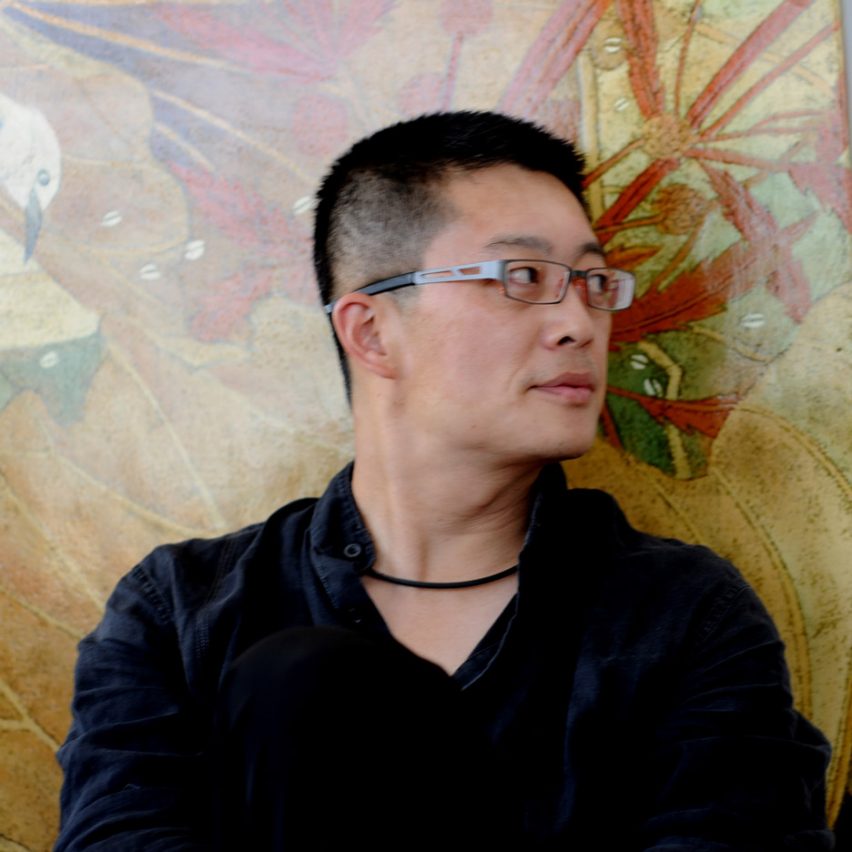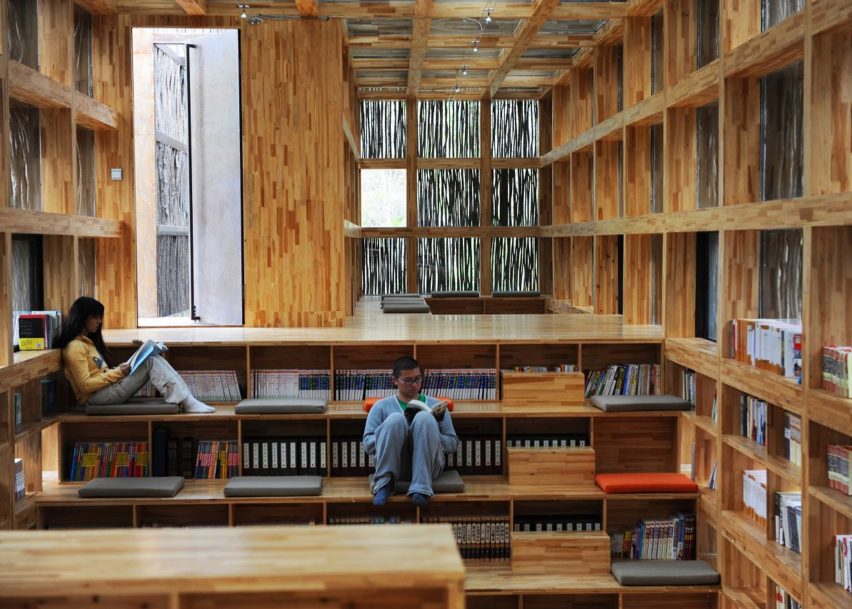
Chinese architects must find a new way to "urbanise the countryside" says Li Xiaodong
Chinese architects must gain the confidence to develop China's rural areas sustainably, not just turn them into urban sprawl, says architect Li Xiaodong.
Li, whose projects include Liyuan Library in the Chinese village of Huairou, believes China's architects must develop a unique understanding of their cultural identity in order to build the architecture the country needs.
"The reason we need to urbanise the countryside is to make the running operation of the economy there efficient," he told Dezeen. "It's about infrastructure, it's about efficiency of how to use the land instead of just turning it into urban space."

With a population of 1.4 billion, China faces unique challenges. Four decades of rapid urbanisation has been fuelled by the labour of younger people leaving behind farming for life in China's cities.
The country has one fifth of the world's population but only one tenth of its farmland.
Chinese architects must "solve problems"
According to Li, who is one of the judges for Dezeen Awards 2019, it is up to China's architects to rise to the challenge of developing the countryside more sustainably to meet the country's food needs.
"If there's no more countryside who is going to feed 1.4 billion people?" he said.
"In Singapore they don't have agriculture, they just buy food from the mainland, it's easy. If we bought food for the Chinese population there would be a war. We have to solve these problems ourselves, not make problems."
Owning rural land is illegal in China. The communal farms of Mao Zedong's regime were abolished 40 years ago, but the state or the village collective still owns the land. Rural populations have halved since the 1980s, and violent clashes over local governments requisitioning farmland for developments are becoming more common.
The solution, Xiaodong argues is not to simply turn rural farming communities into cities with identical high rise buildings, but to modernise existing towns and villages without encroaching on agriculture.

"Instead of just turning the countryside into urban, we should keep the farmland untouched and only build on the footprint of existing households," said Xiaodong.
When designing offices and dormitories on a mountainside in Zhejiang Province, Xiaodong designed a set of brickwork structures that impacted as minimally as possible on their pristine natural surroundings.
China "doesn't need to build high rise buildings"
As for the existing cities, Xiaodong wants architects to stop building high-rise towers and create low-rise yet high density solutions.
"You see the skylines in Shanghai, in Beijing, they are similar to Singapore, Hong Kong, New York. It's a waste of money. A confident, modern society doesn't need to build high-rise buildings," he said.
"I think every architecture needs to be local, to be original. Only that way is sustainable, in terms of resources," said Xiodong. "We have minimal resources now, if we copy a lot that costs money."
Xiodong argued that a lack of original, homegrown design has been endemic since China's Communist Party opened its doors to the West in 1978, starting the period of economic reform that has seen it become the largest single contributor to world growth since the financial crash.
"For the last 20 or 30 years architects have mainly copied and pasted. You feel that they are under the shadow of [the] star architects," he said. "You need to look out at the world first, then look back at yourself to understand the situation."
China must "consolidate our confidence"
Young architects should look further back into China's cultural history to develop a more original approach to design, he claims.
"We talk about space more than any other culture. Because space as a concept existed in Chinese culture 2,000 years ago," he said.
"It allows the saying that it is the contained that is more important than the container. But the west always thinks of the object not the space. So that's a cultural difference. And now I think that kind of understanding about space, about energy flow within the space is going to be a major concept we can engage with in design."

Chinese architects must "consolidate our confidence based on the understanding of our own identity" in order to move forward, argued Xiaodong.
"To do a building with a soul, you need confidence," he said. Design is about design, it's not about copying. That's why you need confidence."
Read on for the full, edited transcript of the interview with Li Xiaodong:
India Block: What is the history of China's identity crises that China? Why is it an issue that China has to grapple with?
Li Xiaodong: This issue is important for everyone, for every culture. As an individual you are part of a family, part of a culture, part of a country, and I think for everyone it's a top priority to define who we are. Especially for designers, you need a base, you need to understand the big scenario, the big issues.
China especially so, because China has been through a very long time of crisis in terms of identity. China was always a major power in the world, but for the last 200 years China has been down, starting from the Ming Dynasty.
Only in the recently in 40 years has China has started picking up, with our science, our technology. But culturally we were not that confident, we are struggling for identities. Because when we opened the door the contrast between us and the rest of the world is so major. Most of these young people have lost confidence about our culture, creating this cultural crisis about ourselves.
Now it's time to change the situation, we should pick up our confidence again. That's why I think it's very important, because the economy is getting bigger but the next step is to define clearly who we are, to move forward.
India Block: In order to move forward do architects need to look back to this rich cultural history?
Li Xiaodong: Not just looking backwards, I think it's more looking forwards. Standing in the point of view of the future to look at the problems we are having now and prescribe the future lifestyle. I think that's the architect's job.
But to do that you need to be confident. You need to know where you come from to project the future. It's not to copy or learn directly from the past, but rather to pre-describe what's going to happen in the future based on your understanding of the past.
Of course, we can draw a lot of inspiration from the past. We do have a really rich past. The Tao, I Ching, Confucianism, Chinese medicine, there's a lot that we've forgotten about. There are many ideas that are still working for now.
India Block: How can Chinese architects gain confidence?
Li Xiaodong: That's the task for maybe five years or more, maybe 30. Learning in school covers only the basic things of architecture. Columns, roofs, walls, ceilings, how to put up a building.
But to do a building with a soul, you need confidence. You also need to be brave enough to enter the unknown zone.
Design is about design, it's not about copying. That's why you need confidence. Without that root into your background it's very hard, because you are floating there.
India Block: Would you say it's an exciting time for architecture in China?
Li Xiaodong: It is an exciting time now, because you need to open up your vision, and to do that you need to understand the world. It's not just your own culture, but the whole world's.
I always think Singapore is a very good example for China. In the 80s and 90s Singapore's architects were not confident, which is why they invited international architects to practice there, to give them ideas. But then they found out those people from outside they didn't touch too much on the local culture and local issues, they didn't understand the Singaporean lifestyle.
Only Singaporean's understand the lifestyles in Singapore, and only when they opened their vision to understand the world themselves, then they start to pick up the issues. They started to design based on their understanding of the issues.
Now, Singapore architecture is very in the mainstream. They export their ideas to all the Asian countries. They are very powerful now because they base their ideas on their understanding of their culture. I think that's the most important thing.
India Block: So it needs to be Chinese architects looking out at the rest of the world?
Li Xiaodong: Yes. You need to look out at the world first, then look back at yourself to understand the situation. And pick up the main issues and then deal with the main issues. Do not copy a lot.
For the last 20 or thirty years architects have mainly copied and pasted. You feel that they are under the shadow of Star Architects.
We are young, we are an ancient country but somehow for modern architecture, for industrialisation, we are very young, just started for two or three decades. So architecture needs ideas, we need experience, we need practice, to become mature.
India Block: Can you give me some examples of the kind of things that only a Chinese architect could know?
Li Xiaodong: Not terms of physical form but of the essence of Chinese culture. For instance, we talk about space, right, more than any other culture. Because space as a concept existed in Chinese culture 2,000 years ago.
It allows the saying that it is the contained that is more important than the container, and this saying was from 2,000 years ago. But the West always thinks of the object not the space. So that's a cultural difference. And now I think that kind of understanding about space, about energy flow within the space is going to be a major concept we can engage with in design.
India Block: What are the pitfalls for Western eyes looking at contemporary Chinese architecture. What is it that we don't see or understand from that distance?
Li Xiaodong: I think it should be even easier for you guys than for the Chinese guys to look at contemporary Chinese architecture, because you have a base from the West, right? So you have a reference.
When you look at Chinese architecture you can tell the difference and the things in common; what is a copy and what is original.
My criticism is that we build in the same way now, we still copy, which is a pity. I think every architecture needs to be local, to be original. Only that way is sustainable, in terms of resources. We have minimal resources now, if we copy a lot that costs money.
India Block:Is there a risk that China will continue to copy from other country's architecture, particularly with its cites?
Li Xiaodong: In many cases, yes. Because if you see the skylines in Shanghai, in Beijing, they are similar to Singapore, Hong Kong, New York. It's a waste of money.
Only when you are not confident about yourself do you put up a high rise building. You are eager to become part of the global family, so you use high rise skylines as a symbol for modernisation. That's why in Dubai and many Asian countries they use skyscrapers as a symbol.
India Block: To say to the world that we are modernised now.
Li Xiaodong: You're from the UK, you can see in London they don't have many skyscrapers because you don't need them. You only have them where you need them, only where density is a must, then you have to build up high.
India Block: So what sort of architecture does Beijing need, then? What is the challenge for young Chinese architects today?
Li Xiaodong: To consolidate our confidence based on the understanding of our own identity. I think that's something we need to do. But that takes time, you know it takes time. We are a young Asian country. Young in terms of the globalisation process, we are beginners, we are young students. But our Asian-ness has a long history, which is a treasure.
We didn't understand the treasure in the 80s, because in the 80s people were still worried or suspicious of our own culture because when we started to open the door we saw Hong Kong, Taiwan, all those small islands were better off than us as the main culture before. So then we had to learn from the outside. We became very suspicious of our own culture.
India Block: Do you think that because you are so young you can perhaps see where other cities have made mistakes? Is that an opportunity?
Li Xiaodong: You mean what's the next stage? We still have a lot of countryside to be urbanised, and I think we should stop doing master plans for those urban conditions into the high rise buildings, we shouldn't do that. Instead of just turning the countryside into urban, rather we should somehow keep the farmland untouched, only building on the footprint of existing households.
The reason we need to urbanise the countryside is to make the running operation of an economy in that place efficient. It's about infrastructure, it's about efficiency of how to use the land instead of turning them into urban. You see they try to make farmers into urban people. But they don't have any identity anymore, because they were farmers before.
China is a big country, a big population of 1.3 billion, and if there's no more countryside who is going to feed 1.3 billion people? In Singapore they don't have agriculture, they just buy food from the mainland, it's easy. If we bought food for the Chinese population there would be a war. Otherwise what do you do, how do you feed 1.3 billion people?
We have to solve these problems ourselves, not make problems.
India Block: With such a big population and these dense urban centres, how can architects such as yourself respond to the challenges of spacial restrictions?
Li Xiaodong: Before in Beijing we had the courtyard house. We went horizontally when we had less than one million people, we could afford to live in this very easy, low density way. But now you have to go up, because we have 24 million people. The population now is 20 times more than 70 years ago. There's no other way, you have to build up.
I designed the high density school [the extension for the School of Architecture at Tsinghua University]. Before you would never design a school with only that small a piece of land, you need space for kids to run around. But in this case, it's in downtown, so I had to go vertical.
This situation is contemporary, so the way you solve them is also contemporary. Independent thinking is based on the real definition of the situation. Then the design will be unique, because there is no other design like that.